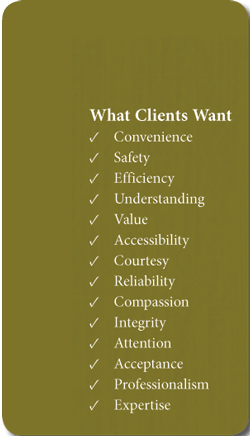The trick is that the effort must be consistent to succeed. This [article] highlights time-tested ways to enhance your customer service so you can avoid the mistake of underemphasizing client retention.
The core of client retention is a solid customer service plan. At the heart of all top-notch customer service plans is one thing – a consistent, careful and creative effort to build strong relationships with clients. In marketing lingo this is referred to as relationship-based marketing, and it involves truly caring about how you can best serve your client’s needs. In essence you become your client’s partner in wellness. It isn’t about convincing or selling; it’s about listening, planning, educating and being proactive. It means going the extra mile to attune to your clients’ needs and taking the time to express your appreciation for their business.
 Customer Service Levels
Customer Service Levels
As in any business, levels of customer service in the wellness field can vary. To give you a picture of these levels, following is a brief description of minimal customer service, good customer service and exceptional customer service.
Minimal Customer Service
For wellness providers, minimal customer service means that you care about your clients, they feel comfortable and safe, your actions are professional and you meet reasonable requests.
Facilitate Clients’ Achieving Their Treatment Goal
Concentrate on addressing clients’ major goals; if you’re a somatic practitioner, focus on the specific requested areas or incorporate other modalities. Keep accurate client files, customize each treatment, stay focused during sessions and be prompt and prepared. Do good work, be a good listener and respect clients.
Use High-Quality Products
Purchase a reliable, sturdy table (with side or length extensions if the table is too small for some of your clients). Provide a variety of lubricants and skin care products and keep an ample supply of clean linens and accessories such as sheets, gowns, bolsters, blankets, pillows, towels and tissues. Maintain a wide selection of music.
Run Your Practice in a Manner That Demonstrates Your Concern
Greet clients cheerfully with a smile and a handshake. Have water for clients to drink before, during and after their session. Share information and resources. Send thank-you notes for referrals. Adhere to a code of ethics. Have an appointment schedule available. Return calls within 24 hours and make confirmation calls. Send appointment reminders when sessions are more than one month apart and call new clients within two days after their initial session. Inspire trust and keep confidences. Be enthusiastic about every meeting – whether it’s the first or fiftieth.
Good Customer Service
Good customer service includes all of the activities under “Minimal Customer Service” plus going the extra step to meet requests. For example, a client shows up for an appointment experiencing a headache. A baseline customer service response would be to focus attention on that condition. Good customer service would include utilizing modalities, equipment or products that aren’t necessarily part of your usual routine, and lengthening the duration of the session if necessary (and appropriate) until the headache is alleviated.
Take a Client-Centered Approach
Develop a long-term wellness/treatment plan with each client. Respond to requests, such as those regarding pressure or modalities. Provide referrals to other practitioners who could do even more with your client. Refrain from talking too much about yourself and keep conversations client-oriented. Conduct thorough intake interviews with regular follow-up assessments. Utilize appropriate equipment. Demonstrate self-care techniques (e.g., stretches) and provide handouts. Review client files prior to appointments.
Make Your Office Environment Comfortable and Inviting
Install a dimmer control for the lighting and use flannel sheets in the winter. Place an oversized stepstool near the table and hang a hook or shelf on the wall for clients’ personal belongings. Use clients’ favorite types of products. Allow clients a few minutes to just lie there before having to get up. If you are a touch therapist, provide access to a shower on premises and towel off oil if necessary.

Exceptional Customer Service
Exceptional customer service requires that you be proactive – anticipating what your clients want – and making those services available. You must know your clients well. This involves taking the time to ask clients about their preferences and thinking ahead about what they might want. When you provide what they need before they know it, your clients appreciate your extra attention and think the world of you. Exceptional customer service incorporates all the activities listed above plus the following communication, session-oriented activities, practice management and support activities.
Elevate the Therapeutic Relationship to a Wellness Partnership with Clients
Always review a client’s charts before their sessions. Before you do any hands-on work, update the clients’ long-term treatment plans and set specific goals for the current sessions. Depending on the type of work you do, consider taking before and after photographs to visually document progress. Take the time to research potentially effective techniques or other recommended services for specific client conditions, and prepare handouts of resources and referrals of other wellness providers. Place a check-in call the day after the first session and whenever a client experiences dramatic changes from your work.
Take a Proactive Approach to Communications
Practice active listening and encourage feedback. Recognize that some clients may have difficulties at times in clearly expressing their needs. Be prepared to act as a communication coach.
Pamper Your Clients
Pamper your clients with state-of-the-art equipment such as a hydraulic table, ergonomic positioning cushions and a luxuriously padded face cradle. Use fine linens, heated booties and mittens, and specialty products (e.g., aromatherapy, sports creams, custom blended oils, personalized skin care formulations and customized herbal formulations). Provide an assortment of beverages such as juices, herbal teas and personal bottles of filtered water (with your sticker attached to the bottles). If it’s cold outside, warm the table or chair with a full-length heated mattress pad and take the chill off any equipment. If you are a touch therapist, have hot packs ready and prepare a warm foot bath. If the weather is warm, be sure that the room temperature is mild and the lights are dimmed. Touch therapists can also offer clients a cool foot bath and a chilled eye pillow in the summer.
Design a Luxurious Office Environment
Furnish your office comfortably, including a private area where clients can put their belongings. Appeal to your clients’ senses by hanging beautiful artwork, and calm them with soothing sounds from an in-room water fountain and an excellent sound system.

Raise the Bar in Your Practice Management Activities
Incorporate excellent customer service into the day-to-day running of your practice. Return phone calls within two hours. Refer people to your clients’ businesses. If you know a client prefers a specific time slot, do your best to keep it available. Send personalized letters to your potential clients, announcing who you are and what you do. Undergo semi-annual peer review, and have your clients evaluate your services annually. Review all client files monthly; look for trends, note if several people are making similar requests, and initiate appropriate changes.
Make Your Clients Feel Special
Offer a free treatment, product or adjunct service on special occasions such as birthdays. Send an anniversary card from their first appointment with you. Give clients something for every referral – either a sample product, a 15-minute session or a free adjunct service such as a paraffin treatment. Ask clients to give you feedback either verbally or on a comment card. Invite clients to test a new product or service before you offer it to the general public. Offer incentives (Top 10 Incentive Ideas) and freebies. Post published newspaper or magazine articles about your clients’ achievements in your office and on your website (with their permission, of course, so as not to violate confidentiality).
Support Client’s Well-Being Outside of Sessions
Stock books and products that can be beneficial to clients – particularly items that aren’t readily available at local emporiums: books on stretching, wellness, carpal tunnel syndrome, workplace ergonomics and self-massage; stretching equipment such as exercise balls and bands; herbs and poultices; massage tools such as rollers and eye pillows; and specialty lotions, sports creams, skin care products and aromatherapy supplies. Keep in touch by sending clients announcements, newsletters, and newspaper or magazine clippings on topics in which they’ve expressed interest. Hold events such as monthly open houses, demonstrations and free workshops for clients and their guests.
Customer Service Action Plans
Customer service action plans grow and evolve throughout your career. The first step in developing a plan is to create a customer service mission statement. It might help to ask yourself what you want clients to say about your level of customer service. If you have been in practice for a while, also survey your current clients for feedback on the items they deem important.
Client Comment Cards
Client comment cards are a great tool for obtaining feedback on how your clients feel about you and your practice. These cards make it safe and convenient for clients to share suggestions, compliments or complaints. They are easy to produce and usually cost-effective. Most people complete comment cards – whether it’s for the offered premium, the opportunity to vent, or simply because they want to assist you in improving your practice. It works best to mail these cards to clients’ homes. Print them as postage-paid response cards to make it convenient for clients to send their comments to you. The next best option is to put a “Client Comment” drop box near the exit.
Comment Card Design Tips
- Use high-quality card stock and make sure the type is large enough to read.
- Create an attention-grabbing headline.
- Mainly ask questions for which the responses can be checked off or filled in with a rating.
- Ask several open-ended questions.
- Request a name, address and phone number.
- Include your name (or someone else in your office) on the return address
Customer Service Action Plan
- Draft your customer service mission statement.
- Outline your goals and list the actions you commit to take.
- Answer the following questions for each activity:
1. Is this important to my clients?
2. How will this add value for my clients?
3. Is this the best use of my time and resources?
4. How will my clients know about these actions?
Customer service techniques are only powerful if your clients are aware of them. You could implement major changes, but if your clients aren’t directly informed, they might never notice. There is one caveat to customer service actions: Never implement a customer service activity that you aren’t willing to consistently continue. Once your clients become accustomed to a certain level of treatment, they expect it and are offended if you are remiss. Ultimately the key to going beyond customer service is to inspire your clients to move from a space of client satisfaction to one of client enthusiasm. Ideally this results in “glowing reviews” that naturally translate into word-of-mouth referrals.
10 Phrases for Poor Customer Service
- “I don’t do that.”
- “Can you call back later?”
- “That’s not my problem.”
- “It’s against policy.”
- “You don’t understand.”
- “What do you expect me to do about it?”
- “Let me put you on hold.”
- “I’ll get around to it.”
- “No one’s ever complained before.”
- “Make it quick.”
Prevent No-Shows
The client retention process begins before you actually see a client for the first time. This is where the pre-interview comes into play. Whenever new clients book an appointment, take the time to make them comfortable. Ascertain if they have any concerns or questions and address them. Get them involved from the beginning. Find out what they need and explain how your specific abilities can support them (or refer them to an appropriate allied professional). Just because a new or returning client schedules a session, it doesn’t mean he will show up. You can reduce the number of no-shows by incorporating the following tips into your office procedures.
Tips to Reduce No-Shows
- Send a welcome letter, your brochure and information about your practice prior to the first appointment (preferably immediately after the telephone call when the session is booked).
- Ideally, send a “Welcome” kit. Items to include in this kit are: a personalized welcome letter; your specific practice brochure; a pamphlet describing (in friendly language) what a client can expect from your services, what they need to do to prepare for the session, your policies and your procedures; several business cards; client intake and health history forms; a sample gift certificate, your recent newsletter; a map to your office (if it’s not already on the back of your brochure); and other promotional materials (e.g., a copy of a published interview). This may sound like a lot of material, but the few dollars it costs to assemble and mail this kit demonstrates your professionalism and concern about your clients.
- Confirm appointments by telephoning your clients the day before their sessions, sending reminder notes or both.
- Give clients an appointment reminder card to take home. Include your cancellation policy on this card.
- Give clients a copy of their treatment plan.
- If applicable, offer home assignments or a list of wellness tips that are designed to assist clients in attaining their wellness goals.
If you follow these steps, you will minimize the no-show factor and won’t be so disconcerted if the occasional last-minute cancellation or no-show occurs. I’ve found that when this has happened to me – it was perfect. Either I wanted to do something else anyway or another client would call wanting to come in right away (and fill the vacant appointment slot).
The Client:
... is the most important person in our business.
... is the reason for our work, not an interruption.
... is doing us a favor by purchasing our services and goods.
... is a feeling human being.
... is someone who wants a break – to be taken care of.
... is the person who enables us to earn an income.
... is deserving of the best service we can offer.

Incentive Programs
Incentive plans serve to reward loyal clients and to create a way to increase the session frequency for others who simply can’t afford to receive treatments as often as desired. The following ideas are geared to spark your creativity. Adapt them for your specific needs and desired results.
Top 10 Incentive Ideas
- Offer prepaid package discounts such as: purchase three sessions and receive a 10 percent discount; seven sessions qualifies for a 20 percent discount; purchase eight sessions and receive two for free.
- Present clients with a Frequent Buyer Card. This can be done in two ways: clients receive a free session after seeing you for a set number of sessions, (e.g., “Buy 10, Get Your 11th Session Free!); or give a free session for a specific number of sessions a client receives within a certain period of time (e.g., “Receive 5 Treatments in 2 Months and your 6th treatment is Free!”).
- Provide a certificate for 50 percent off the client’s next session whenever a client refers a new client.
- Send clients an “I Enjoyed Working with You” packet. After a client’s first visit, send a greeting card that states it was a pleasure working with her and that you look forward to helping her achieve her wellness goals. Include a coupon for a complimentary adjunct service or product to be used with her next appointment.
- Give clients a half-hour session certificate for every referral.
- Give clients an adjunct service for every referral.
- Have clients sponsor a demonstration party – and thus receive at least one free session, with the potential for many more.
Offer holiday specials: For example a touch therapist could allow clients to purchase half-hour certificates at half price with every full-hour session they purchase. These half-hour certificates can be combined for full sessions or given as gifts. - Give a free mini-session for birthdays.
- Offer a two-for-one Valentine’s Day special.
Your incentive program need not be limited to your hands-on work. For all the previous examples you can substitute products, adjunct services and seminar registrations.
These incentive suggestions serve a dual purpose – they acknowledge your current clients, and many of the ideas provide a means to inspire referrals from your clients. It’s wonderful to combine client retention techniques with your promotional endeavors. However, don’t rely on your clients to build your practice. It isn’t their responsibility. They may be uncomfortable telling others about your services – many consider their wellness an extremely private matter.
Session Completion Protocol
Your session doesn’t really end until your client walks out the door. After the technical one-on-one work is done (e.g., the massage is over, the nutritional consultation is conducted, the movement instruction is finished), it’s time to do the session completion protocol. Briefly review what occurred in the session, highlight some of the client’s major goals, assign homework, give the client an opportunity to ask questions, make any necessary referrals and schedule the next appointment. Give the client several of your cards and brochures, a copy of his treatment plan (or offer to email it later) and any appropriate educational handouts.
If you don’t follow a session completion protocol, I still recommend asking the client, “When would you like to schedule another session?” If the client appears hesitant, suggest he calls you back when he has his appointment book handy. Don’t be pushy. Tell him that you hope to hear from him soon and send him off with the appropriate educational and marketing materials.
Cherie Sohnen-Moe is an author, business coach, international workshop leader, and successful business owner since 1978, including being in private practice for many years as a massage and holistic health practioner. Sohnen-Moe has served on the faculty of several schools and has written over 100 articles that have been published in more than 15 national and international magazines. www.sohnen-moe.com
